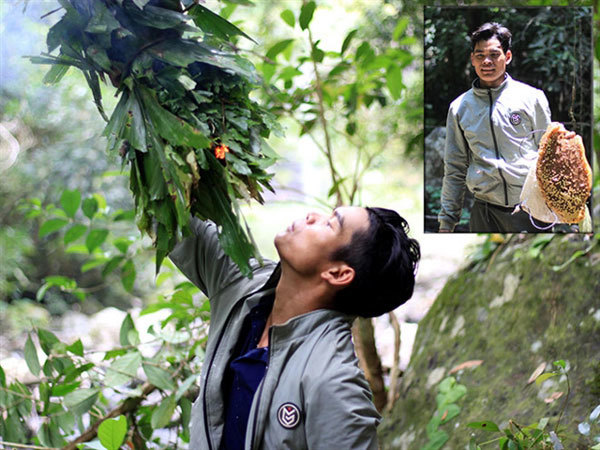As busy as a bee hunter can be
Honey season in Hung Yen
The sweet lives of bee hunters
Hunting wild honey in central Vietnam: In pictures
Life of a bee hunter
Honey harvesting season in Hung Yen
 |
| Dinh Diep, a wild bee hunter from Sơ Ró Commune, Kông Chro District, Gia Lai Province, burns leaves to smoke the bees from the hive to collect the honey. Photo thanhnien.vn |
Every day, they rush to the forests to look for beehives and collect the natural honey.
The best time to find beehives is from the 4th to the 8th lunar months.
Despite the difficulties and dangers, local farmers in the Đăk Pơ, Kông Chro and Kbang districts of Gia Lai Province still roam the forest every day looking for honey.
Some simple tools, food and bottles of water are enough for the honey hunters from the Ba Na ethnic minority to start collecting the honey.
Dinh Diep, 30, from Sơ Ró Commune, Kông Chro District, starts his day very early.
He has to ride a motorbike to the forest about 30km from his house to Đăk Pling Commune to harvest the wild honey.
He leaves his motorbike and follows the streams to waterfalls, where bees often congregate.
“Bees often come here to drink water and then fly back to their hive. I'd follow the bees to find the hive. Every honey hunter has their own tricks,” Diep told Thanh Niên (Young People) newspaper.
To collect wild honeycombs, hunters have to climb trees tens of metres tall or cling to the rocks to poke the beehives, according to Diep.
Experienced hunters say they usually get beehives at night to be safe. During the day they make a ladder to reach the hives.
Diep said to get a beehive, a bee hunter often wears protective clothing.
Then they burn small branches to lure the bees out, according to Diep.
After collecting the honey, Diep carves a few letters on the tree trunk to tell people the honey from the hive has already been tapped.
Vietnam has developed a lot of beekeeping farms to meet the increasing demand, but wild honey is still preferred. Therefore, the price of wild honey is always quite high, at about VND500,000-600,000 per litre.
Hunting wild bees is now considered a lucrative job for many of the Ba Na ethnic minority group. But they always bear in mind the need to protect the forest and the young bees, part out of the deference to the forests' spirits and part out of the concerns for the longevity of their own livelihoods.
They always leave the part of the hive with the pupas so that the bees will not leave the hive and help bees regenerate.
In Kbang District, the majestic waterfalls are always full of water in the dry season, which provides ideal conditions for thousands of bees to come to nest.
Dinh Van Dai, from Son Lang Commune, is 25 years old but has spent over ten years hunting wild bees in the surrounding forests.
At a young age, Dai followed local adults into the forest. From watching the bees a few times by the streams, he was able to learn the sites that might sport a beehive.
“Many people want to buy honey collected in this region due to its high quality,” said Dai.
According to Dai, the job is quite dangerous. Experienced hunters sometimes have to be hospitalised due to bee stings.
Dinh Veu, 70, an experienced bee hunter in Đăk Roong, remembered that he once found a very big honey comb with dozens of litres of honey.
“Many years ago, we used to collect honey to exchange for food such as salt or fish. Now, bee traders wait for young hunters at the entrance to the forest to buy their honey immediately,” Veu said.
VNS
 Rice harvest season just ended, but many farmers in the Central Highlands’ provinces are still hard at work.
Rice harvest season just ended, but many farmers in the Central Highlands’ provinces are still hard at work.